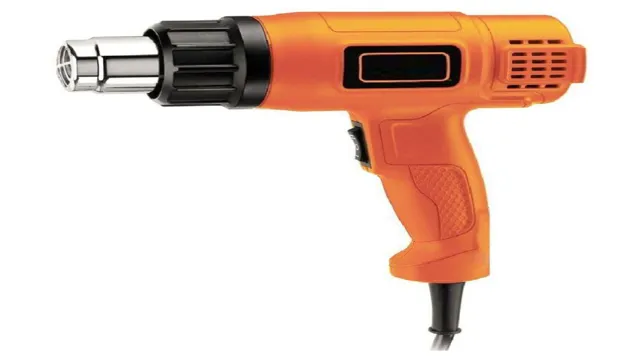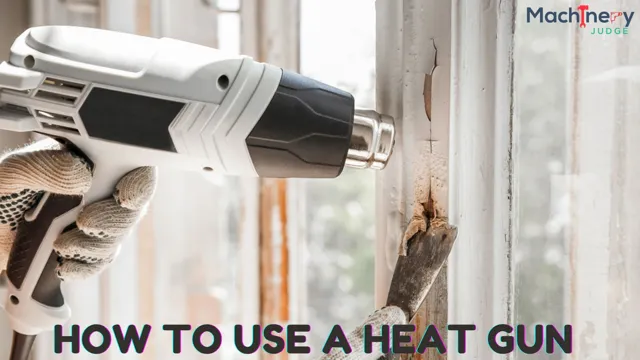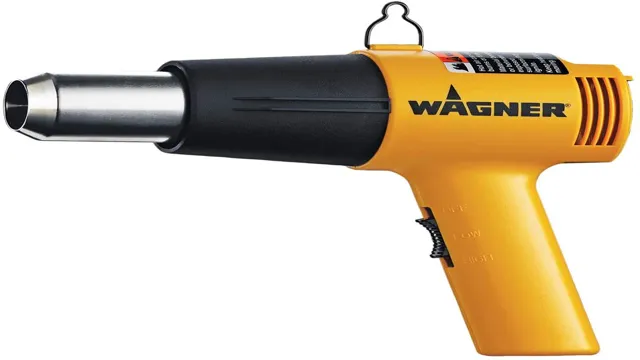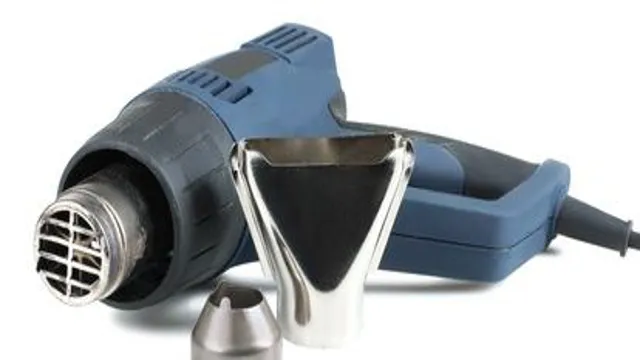Can You Use a Blow Dryer as a Heat Gun: Understanding the Key Differences
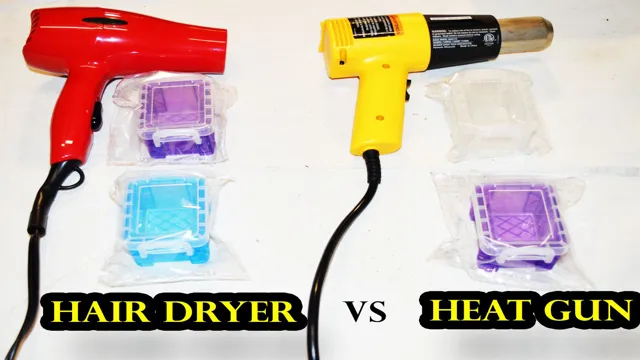
Do you have a project that requires a heat gun but can’t seem to find yours? Well, before you run to the store to buy a new one, you might want to consider using a blow dryer as a substitute. Yes, you read that right – a blow dryer can be used as a heat gun! They both produce heated air, and while their temperatures may differ, a blow dryer can still heat up certain materials and perform tasks that a heat gun would typically do. Of course, there are some limitations to using a blow dryer as a heat gun, such as not being able to thoroughly melt glue or bend plastic.
However, tasks such as removing stickers, drying paint, and thawing frozen pipes are all possible with a blow dryer. So next time you find yourself in need of a heat gun, don’t underestimate the power of your trusty blow dryer. It might just surprise you with its versatility and ability to get the job done.
Understanding the Differences Between a Blow Dryer and a Heat Gun
If you’ve ever needed to apply heat to something and didn’t have a heat gun, you might have wondered if you could use a blow dryer instead. While both tools do produce heat, there are some key differences between them. A blow dryer typically produces a lower temperature of heat, which is intended for use on hair and may not be hot enough for other tasks.
In contrast, a heat gun produces much higher temperatures and can be used for a variety of tasks such as removing paint or shaping plastic. So while you might be able to use a blow dryer in a pinch, it’s not always a good substitute for a heat gun when it comes to projects that require high heat levels. Remember, safety should always come first when using any tool that produces heat!
Temperature Output and Airflow
When it comes to temperature output and airflow, there are some important differences between a blow dryer and a heat gun. While both of these tools blow air, a heat gun is designed to generate much hotter temperatures than a blow dryer. This is because a heat gun is typically used for tasks that require more heat, such as soldering or paint stripping.
In contrast, a blow dryer is typically used for drying and styling hair, and usually comes with a range of heat settings to suit different hair types. Additionally, blow dryers typically have a lower airflow than heat guns, as a stronger airflow can cause hair damage. Overall, it’s important to choose the right tool for the job to avoid any unnecessary damage or injury.
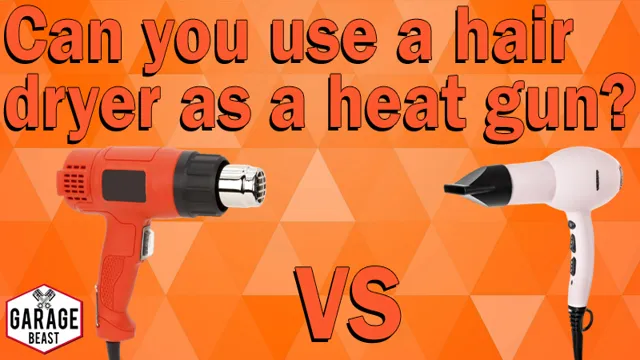
Purpose and Intended Use
When it comes to styling your hair, you may find yourself wondering about the differences between a blow dryer and a heat gun. While both tools use heat to dry and style your hair, they serve different purposes. A blow dryer is designed to blow out hot air, creating airflow that helps to dry your hair and shape it in a particular way.
A heat gun, on the other hand, is a much more powerful tool that produces a high amount of heat and can be used for tasks like shrinking plastic or removing paint. When it comes to using either of these tools for your hair, it’s essential to make sure you use the correct one for the job. If you’re looking to style your hair, a blow dryer is the better choice, as it’s much less powerful and won’t damage or overheat your hair.
However, if you’re working on a home improvement project and need a tool that can generate high levels of heat, a heat gun is the better option. Always consider your intended use carefully before selecting which tool to use.
When to Use a Blow Dryer Instead of a Heat Gun
If you’re wondering whether a blow dryer can serve as a heat gun, the answer is “yes,” but only in certain situations. A blow dryer can be a suitable substitute for a heat gun when the task requires low to medium heat intensity. Heat guns excel when you need to generate high amounts of heat quickly, while blow dryers provide a lower level of heat.
As a result, blow dryers are ideal for drying and styling hair, while heat guns are perfect for tasks such as stripping paint or bending plastic pipes. Moreover, blow dryers have a user-friendly design and can be teamed up with various nozzle attachments, making them versatile tools for multiple applications. However, it’s crucial to remember that blow dryers typically don’t have an option to adjust the temperature, so they can’t rival the precisely controlled heating a heat gun provides.
So, while blow dryers can work as a heat gun in certain cases, it’s essential to ensure that you’re using the right tool for the job.
Drying and Styling Hair
Blow dryer, Heat gun When it comes to drying and styling hair, one common question arises: when should you use a blow dryer instead of a heat gun? Well, the answer depends on what you’re trying to accomplish. If you want to dry your hair quickly, a blow dryer is the way to go. It’s designed to blow hot air over your wet hair, evaporating the moisture and leaving your hair dry and smooth.
On the other hand, if you want to style your hair, a heat gun may be the better choice. Heat guns are typically more powerful than blow dryers and can reach higher temperatures, making them ideal for sculpting and molding hair. However, it’s important to note that heat guns can be extremely hot and should be used with caution.
In general, if you’re just looking to dry your hair, a blow dryer should do the trick. But if you’re looking to create a specific hairstyle, a heat gun might be the better option – just be sure to use it carefully and with protective gear.
Removing Dust and Debris
Blow dryer instead of heat gun When it comes to removing dust and debris from various surfaces, many people turn to heat guns to get the job done. However, a blow dryer can also be a handy tool to have in your arsenal. But when should you use a blow dryer instead of a heat gun? One situation where a blow dryer is the better option is when you’re dealing with delicate materials.
Heat guns can generate extremely high temperatures that can damage or melt certain surfaces, such as plastic or fabrics. A blow dryer, on the other hand, typically operates at a lower temperature, making it a safer choice for sensitive materials. Another factor to consider is the distance between the tool and the surface you’re cleaning.
Heat guns require you to keep a certain distance to avoid causing damage, whereas a blow dryer can be used at a closer distance without any risk. This makes it easier to get into tight spaces or to clean hard-to-reach areas. Lastly, a blow dryer can also be a better choice when you’re in a hurry.
Heat guns can take time to warm up before you can start using them, and they also require a cool-down period before they can be put away safely. A blow dryer, on the other hand, is ready to go as soon as you plug it in and turn it on. In conclusion, while heat guns are a popular choice for removing dust and debris, there are times when a blow dryer is the better option.
By considering the materials you’re working with, the distance you need to be from the surface, and your timeline, you can determine which tool is best for the job.
Softening Adhesive Materials
If you’re working with adhesive materials that need to be softened, you have a few options for how to apply heat. Heat guns are a popular choice, but sometimes a blow dryer can work just as well – or even better. One example would be if you are working with a smaller area that requires heat application, such as a sticker that needs to be removed from a surface.
In this case, a heat gun may be too powerful and challenging to maneuver in tight spaces. A blow dryer can provide a gentler stream of heat that will soften the adhesive and allow for easier removal. Additionally, if you need to soften multiple objects that are close together, a heat gun may transfer heat to other nearby objects and possibly damage them.
In contrast, a blow dryer can be aimed more precisely at the desired area without affecting surrounding materials. Ultimately, the choice between using a heat gun or blow dryer will depend on the specifics of your project, but it’s good to know that a blow dryer can be a valuable tool in some cases.
When a Heat Gun is Necessary
While a blow dryer and heat gun may seem interchangeable, they actually have different purposes. A blow dryer is designed to dry hair, while a heat gun is used for more heavy-duty tasks, such as stripping paint or thawing frozen pipes. While some may be tempted to use a blow dryer in place of a heat gun, it is important to note that blow dryers do not produce the same level of heat intensity as heat guns and are not suitable for many tasks.
Furthermore, a blow dryer typically has a much smaller nozzle which makes it difficult to direct heat to a specific area, whereas a heat gun offers greater precision and control. So, while a blow dryer may work for basic tasks, if you need more intense and specific heat, it’s best to opt for a heat gun instead.
Removing Paint and Adhesives
When it comes to removing paint and adhesives, sometimes a heat gun is necessary. While there are other methods for removing these substances, such as sanding or using solvents, they can be time-consuming and messy. A heat gun, on the other hand, uses high heat to soften the paint or adhesive, making it easier to scrape off with a paint scraper or putty knife.
Not all heat guns are created equal, however, so it’s important to choose the right one for the job. Look for a heat gun with adjustable temperature settings, as different materials will require different levels of heat. Keep in mind that using a heat gun can be dangerous if not used properly, so it’s important to follow safety precautions such as wearing heat-resistant gloves and eye protection.
By using a heat gun for paint and adhesive removal, you can save time and achieve a smooth, clean surface for your next project.
Shrinking Heat-Shrinkable Materials
Heat-shrinkable materials are an indispensable part of various industries, including electronics, aerospace, and automotive. These materials have the unique ability to shrink when heated, making them perfect for insulating wires, protecting components and connectors, and providing seals. However, to activate the shrinking process, a heat gun is necessary.
The heat gun emits a concentrated stream of hot air, which heats the material and causes it to shrink tightly around the object. This process creates a protective barrier and improves the overall performance and durability of the product. Without a heat gun, it would be impossible to achieve the desired results.
Therefore, if you are working with heat-shrinkable materials, investing in a good quality heat gun is a must. It will save you time, effort, and ensure that your products are of high quality.
Conclusion
In conclusion, while a blow dryer may seem like a viable alternative to a heat gun in a pinch, the reality is that its intended purpose is for styling and not for heating materials to the necessary temperature for certain tasks. So, the next time you’re tempted to use your blow dryer as a heat gun, just remember that while it may seem like a good idea, it could end up blowing up in your face (not literally, we hope). Stick with the proper tool for the job and you’ll avoid any potential hot air disasters.
FAQs
Can a blow dryer be used as a heat gun?
While blow dryers and heat guns share some similarities, they are not interchangeable. A heat gun produces higher temperatures and has a more focused airflow, making it better suited for tasks such as stripping paint or bending plastic. Using a blow dryer for these tasks could result in less-than-optimal results and even be hazardous.
What are some common uses for a heat gun?
Heat guns can be used for a variety of tasks, including removing paint, thawing frozen pipes, welding plastics, and even roasting coffee beans. They are a versatile tool to have in any workshop.
Are all heat guns the same?
No, heat guns come in a variety of sizes and with different features. Some are corded, some are wireless, and others have adjustable temperature settings. It’s important to consider what tasks you will be doing with your heat gun before purchasing one to ensure you get the right tool for the job.
Are heat guns safe to use?
Heat guns can be safe to use when used properly. It’s important to follow the manufacturer’s instructions, wear appropriate safety gear, and never point the heat gun towards yourself or others. Always unplug the heat gun when not in use.
Can a heat gun cause damage to surfaces?
Yes, a heat gun can damage surfaces if used improperly or if the temperature is set too high. It’s important to test a small, inconspicuous area first before applying heat to the entire surface to avoid any damage.
What should I look for when buying a heat gun?
When purchasing a heat gun, consider the temperature range, airflow, cord length, and any additional features such as adjustable temperature settings or interchangeable nozzles. It’s important to choose a heat gun that will meet your needs and be safe to use.
Can a heat gun be used to shrink wrap items?
Yes, a heat gun is an effective tool for shrinking plastic wrap around items. The focused airflow and high temperature help to evenly shrink the wrap, creating a tight, protective seal.

